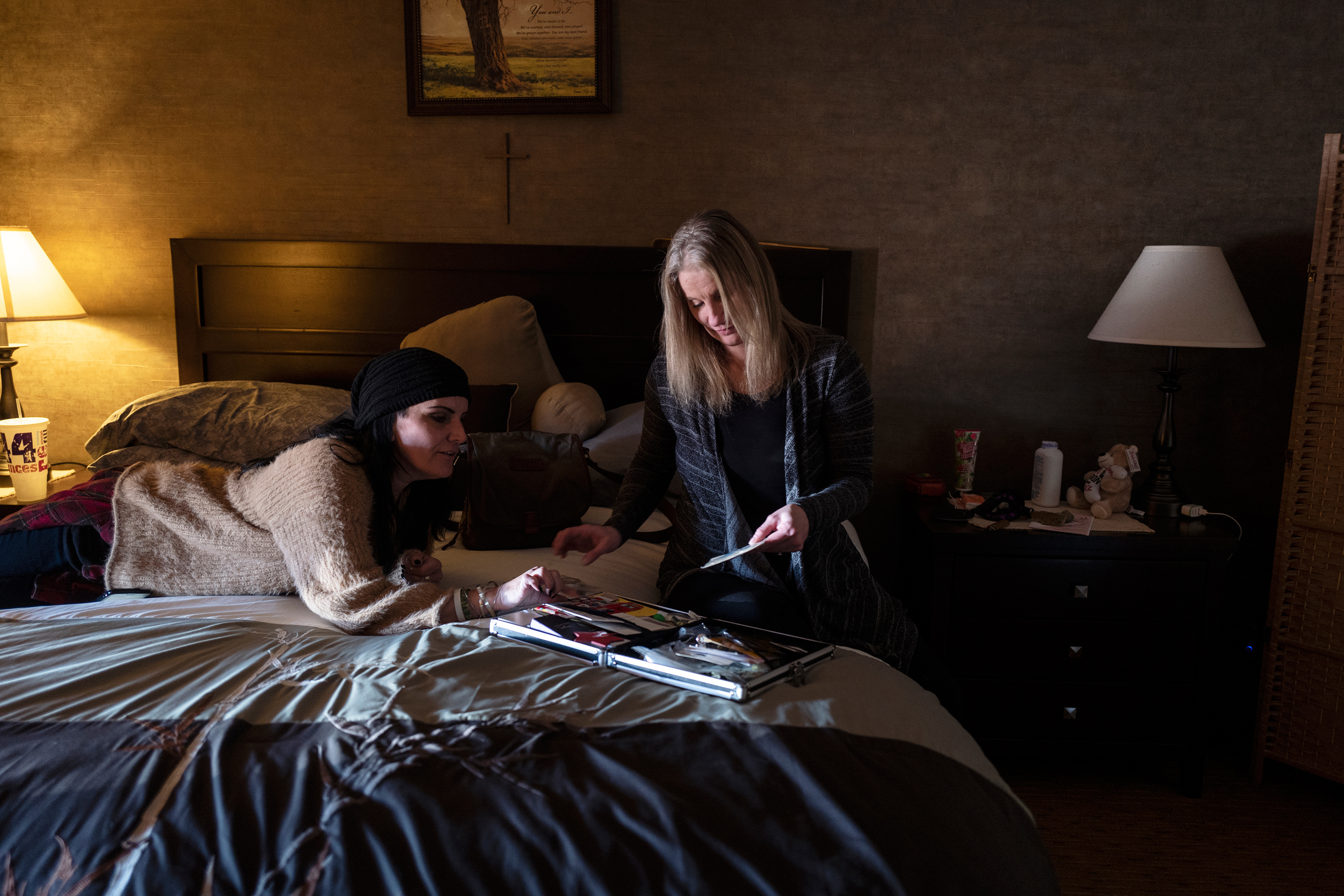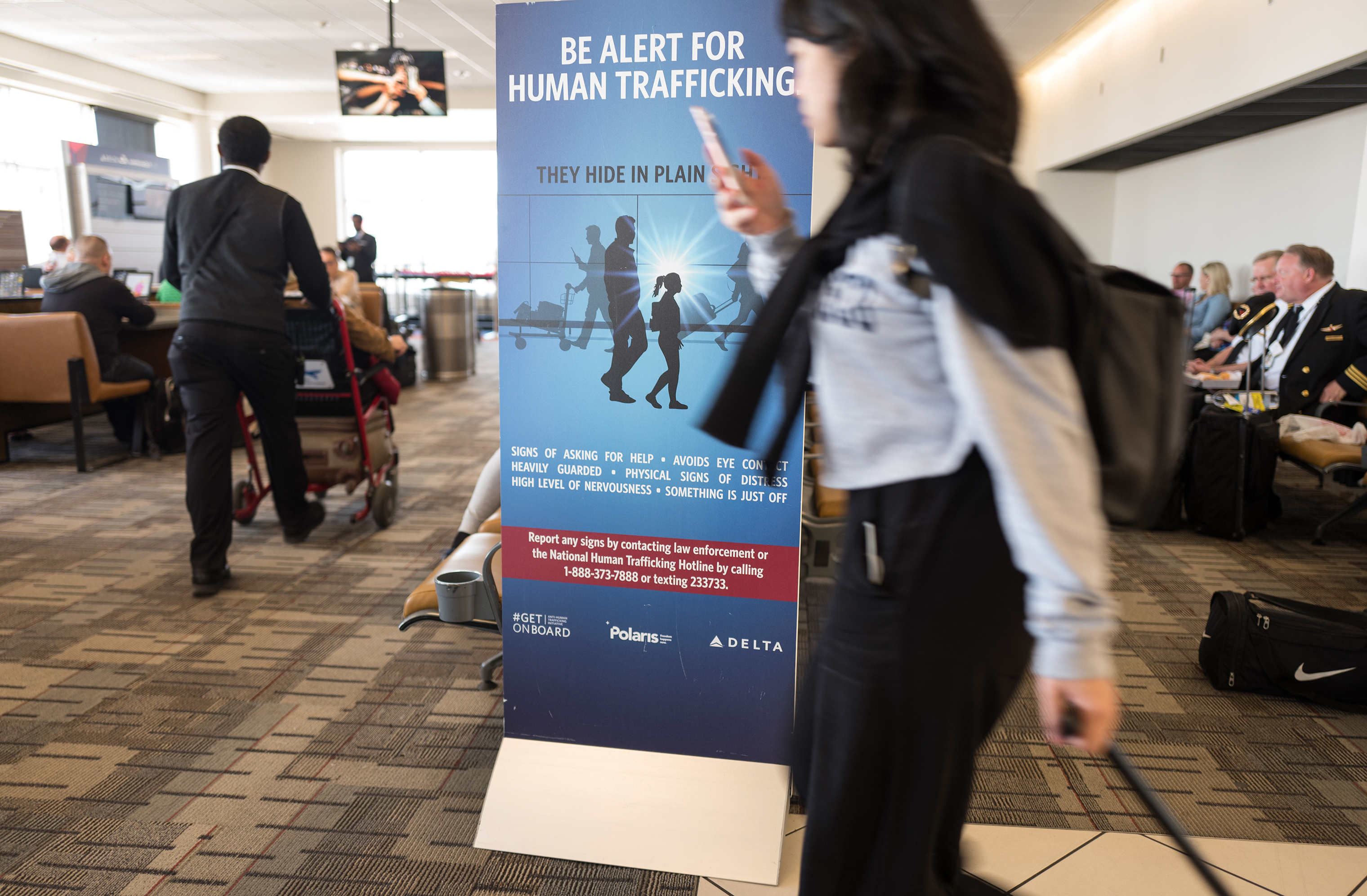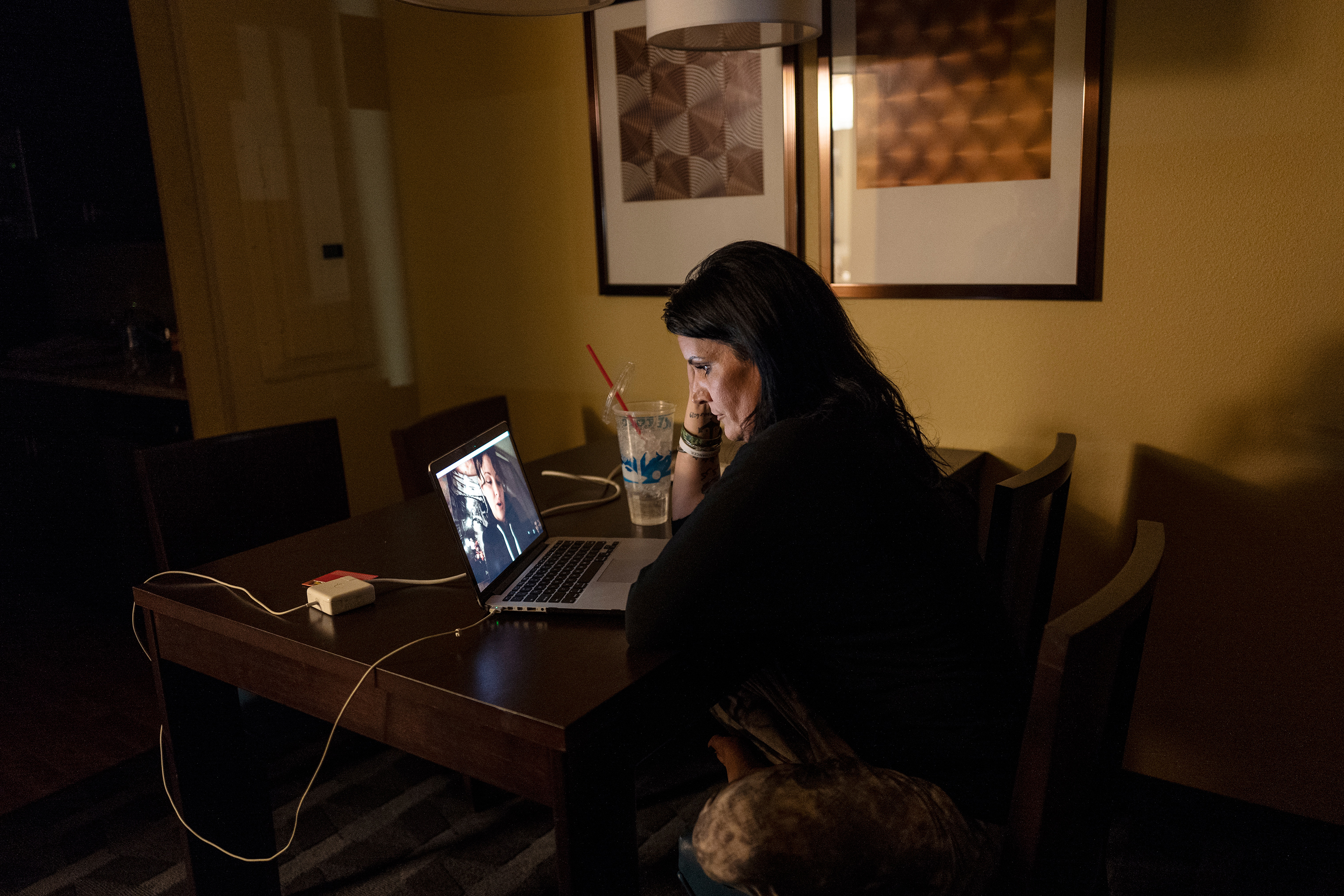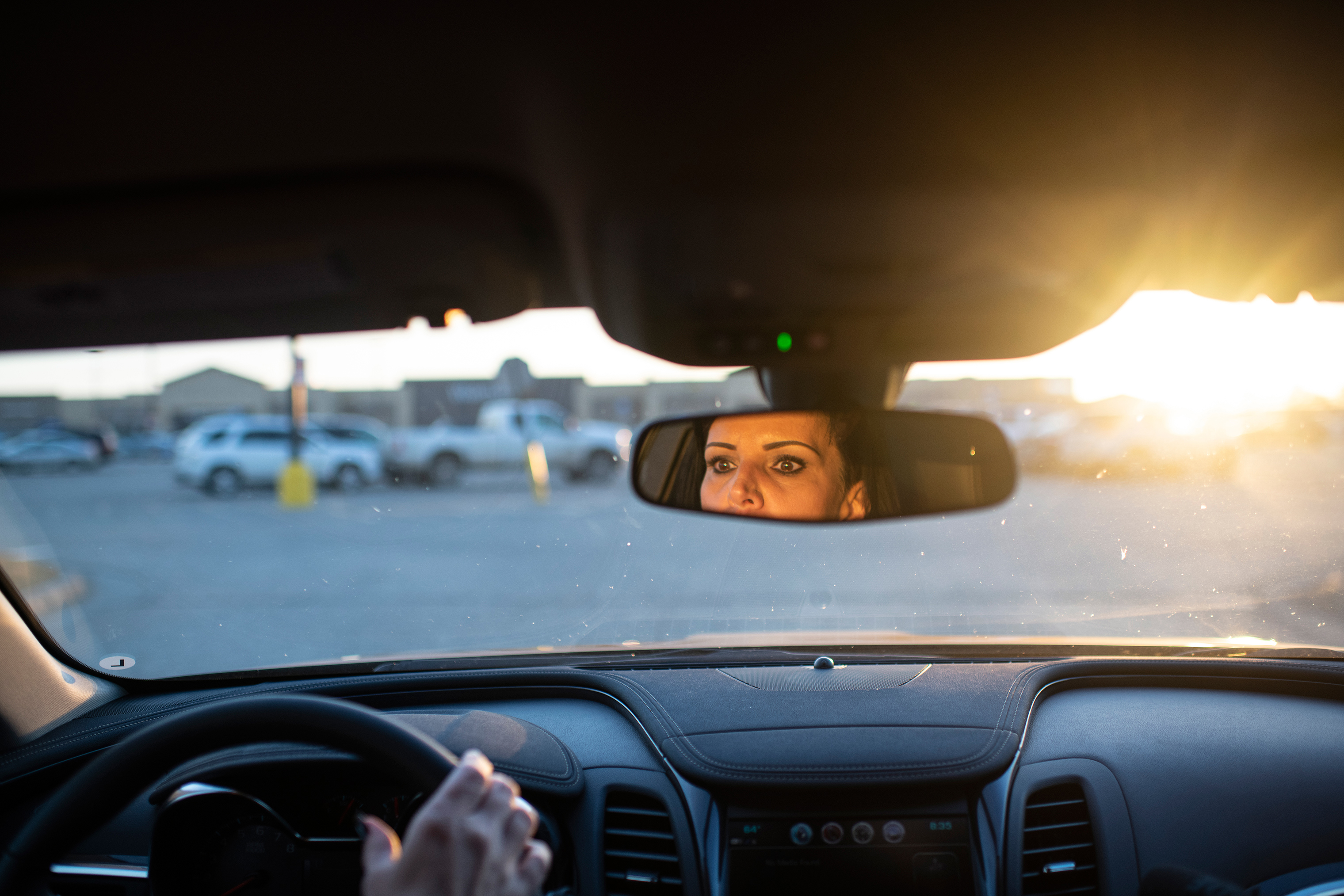“This is where we found that little gal in the snow with nothing on but a T-shirt. Her head had been bashed in by her pimp.” Our headlights rake a desolate embankment on the fringes of Williston, N.D., as Windie Jo Lazenko does a three-point turn and continues her grim tour. Gas flares illuminate the pump jacks in the distance. Just up the road, she says, is where a woman was imprisoned in an RV for several months by a gang of drug dealers. We pass Love’s truck stop, where in 2017 a 19-year-old escaped from a big-rig cab where she’d been held captive. Then we pull into the parking lot of the Grand Williston Hotel, once notorious for the broken lock on its back door that allowed johns to come and go unnoticed by front-desk personnel. “This is where Jae”—a 17-year-old high school student who found herself in prostitution against her will—“was forced to meet her pimp’s quota of $2,000 a night,” says Lazenko, 50, a social worker and survivor of sex trafficking who has spent the past decade campaigning against sexual exploitation and advocating for victims across the U.S. She tests the back door. It still opens.
Watch: The Hidden Epidemic of Sex Trafficking in the U.S.
From 2009 to 2015, when oil prices skyrocketed and technological advances in hydraulic fracturing brought an unprecedented boom to the oil fields of North Dakota, Jae, now 23, could have hit her quota with three tricks. Tens of thousands of workers flooded sleepy towns, seeking entry-level jobs that paid six figures. The influx of cash-flush men brought a huge demand for prostitutes. At one point, Williston and the surrounding area had the highest gender imbalance in the U.S., ranging from 10 to 20 men for every woman, according to city officials. Women couldn’t walk into Walmart without being propositioned, Lazenko recalls. “It was an infestation.”
Sex trafficking, according to the U.S. Department of Justice, occurs when a person performs a commercial sex act through force, fraud or coercion. For under-18-year-olds, it is any kind of commercial sex act. While sometimes perpetrators and their victims cross borders, sex trafficking, including activities such as pimping, does not necessarily involve transport. And it is a $99 billion annual industry that has ensnared an estimated 4.8 million people around the world, mostly women and children, according to a 2014 report from the International Labour Organization, a U.N. agency. While much of the criminal activity is international, the U.S. has its own sex-trafficking problem, with more than 32,000 cases reported in the past decade, according to the National Human Trafficking Hotline, which is run by the anti-trafficking organization Polaris. Since few Americans know how to identify signs of sex trafficking, and even fewer victims are likely to call for help, Polaris CEO Bradley Myles says that number represents only a small fraction of the epidemic’s true size.
The lack of solid data makes it hard to craft an appropriate response, says Bethany Gilot, human-trafficking prevention director at the Florida Department of Children and Families. “There’s still tons of people who don’t believe sex trafficking is an issue in the U.S.,” she says, despite the fact that Florida alone verified 470 cases of child sex trafficking in 2017. Gilot compares sex trafficking today to domestic violence 30 years ago: people had to understand that it existed before anyone could talk about it as a problem. “People just don’t want to know that this is happening in our own great nation.”

In popular imagination, trafficked women tend to be foreigners brought into the U.S. against their will or undocumented immigrants living in fear of exposure. In fact, many are American-born women and girls. According to Department of Justice statistics from 2012, about a quarter of victims are white, a quarter Hispanic and 40% African American. Lazenko has worked with women across the racial spectrum—Latina, Asian, Native American and Hispanic. “These are girls from two-parent homes in the Midwest, girls from the inner city, girls from the reservation,” says Lazenko, who has dyed black hair and kohl-rimmed eyes. “They are valedictorians, rebels and runaways.”
Each case represents a life torn apart, lived under the threat of violence, without free will and defined by rape. Sex trafficking is a form of modern slavery that thrives largely because its victims are dismissed as society’s castaways—hookers, addicts, the homeless—and because its signature act, prostitution, is often shrugged off as a victimless crime. “The worst thing you could ever do with a problem like this is pretend it doesn’t happen, because it will fester and it will grow,” says former Senator Heidi Heitkamp of North Dakota. “That’s why it’s important that we be honest about what’s happening in our communities.”
Windie Lazenko knows the reality better than most. At 13, she fled what she describes as an abusive home life in California for what seemed like the safety of a friendly couple she had met through a local motorcycle gang. (She asked TIME not to identify the gang for fear of retribution.) The couple sheltered her in exchange for small domestic chores that soon became sexual. When Lazenko was 16, they branded her with a tattoo that read property of and sent her to dance at a strip club. Nobody at the club questioned the presence of an underage girl, or the tattoo. Soon after, the couple started prostituting her to friends and fellow gang members. Lazenko, who had dropped out of school, was so bonded to the couple that she didn’t realize what they were doing was wrong. “I was in search of a family, and they provided me with a sense of value, however messed up,” she says. “I saw them as the people who had saved me, when they were actually the people who were victimizing me the worst.”

By 1999, when the gang demanded that she start recruiting other girls, Lazenko realized that she didn’t want anyone else going through what she had experienced. She ran away. “Even then I didn’t realize that I was being trafficked,” she says. “I had no understanding of what was happening to me.”
After a period of reflection and recovery, Lazenko started working with anti-trafficking organizations in 2007, learning on the job how to minister to victims and campaign for awareness. In 2012 she was working for a support organization for sex-trafficking survivors in Florida when she started hearing strippers and sex workers talking about the money to be made in the Bakken oil fields of North Dakota and Montana. Figuring that wherever there was a demand for prostitutes, pimps and traffickers were sure to follow, Lazenko drove to Williston on a reconnaissance mission.
The situation, she says, was “worse than horrific.” Pimps had colonized the two local strip clubs and most of the hotels, but bartenders and front-desk managers had no idea what was going on. “They all thought the women were there by choice,” says Lazenko. The only women’s shelter in town was for domestic-abuse victims, and it wasn’t equipped to deal with trafficking victims. Police investigators, Lazenko says, often ended up alienating and retraumatizing victims with insensitive questions about the number of johns they had slept with or why they never tried to get away.

Lazenko ended up staying in Williston to found 4her North Dakota, a one-woman organization dedicated to helping trafficking victims. She started button-holing hotel managers, front-desk personnel, bartenders and baristas for impromptu training on how to spot signs of trafficking. She taught them to look out for girls in the company of controlling men who won’t let them speak for themselves, women who don’t have their own ID or other personal items, and ownership tattoos like her own or Daddy’s girl. She instructed them on what to do if they suspected someone was being sold for sex. And she gave presentations to the Williston police department about how to treat potential victims, and went with federal investigators on raids.
Today Lazenko spends most of her time on the road, traveling between conferences on sex trafficking and conducting training sessions for cops and social-service organizations. She has testified before state lawmakers and served as an expert witness in sex-trafficking cases in Florida, Arizona, Montana and North Dakota. “We have to keep talking about sex trafficking,” she says, “otherwise it will stay a hidden epidemic.” She is trying to do for trafficked women what she wishes someone had done for her back when she was 13—a challenge even more urgent now that traffickers can use the Internet to find potential victims.
Trafficking can start with something as simple as a flattering comment on Facebook. “Internet Romeos” posing as cute boys can post messages on hundreds of different profiles every day, knowing that a young girl who responds to a stranger may have boundary issues that can be exploited, says Gilot, the Florida anti-trafficking official. “That’s what parents need to understand,” she says. “You might not have traffickers walking around your neighborhood, but with a smartphone or a computer, you can have them right inside your house.”
Romeos groom their targets over several months, building trust and chipping away at a prospective victim’s other relationships. Often, a Romeo will persuade a girl to move with him to a new town. Eventually he’ll engineer a traumatic event to “break” his victim. Then, when she feels she has nowhere else to turn, he forces her into prostitution.

That’s what happened to Jae, a vivacious singer from outside New York City. In 2013 she followed her online boyfriend to Williston, where he told her she could double the salary she earned as a McDonald’s cashier. When she got to North Dakota he started beating her, then forced her to have sex with his dealer in exchange for a couple of grams of methamphetamines. She was 17 at the time.“Things just got out of control,” she says. “I was a good girl from Long Island who made a few wrong decisions.” She broke up with the boyfriend but turned to prostitution to make rent. She fell in with a pimp who offered her security in exchange for a portion of her earnings. When he started taking everything, she no longer felt safe enough to resist and started taking the drugs he supplied to numb the pain. (Jae is not her real name; it’s the nickname she used when posting ads on Backpage.com, a popular online service for escort ads, to meet her pimp’s nightly quota.)
Other women go into prostitution willingly, only to get trapped by a pimp. “I needed money,” says Adale, who started stripping to pay for college in Utah. Then she met a boyfriend who abused her and stole her proceeds. “He broke me down mentally to the point I felt like a worthless piece of sh-t,” she told Lazenko during one of their counseling sessions over Skype, which TIME witnessed. “When people call you a whore, you start to believe it.” With Lazenko’s help, Adale—who asked to be identified by her middle name—is pressing charges against her pimp. (The investigation is ongoing.)
Sometimes the perpetrator is the person closest to the victim. Danielle Knoblauch, a 41-year-old mother of three from Chicago, followed her husband to Dickinson, N.D., in 2012. Working in the oil field, he soon became addicted to meth, which is common among employees toiling through 18-hour days. He lost his job, then started selling drugs to feed his habit. When he was busted and sent to prison, his dealers wanted Knoblauch to pay off his $25,000 debt. She couldn’t, so they took her instead, according to her caseworkers and a law-enforcement official. “People always say, ‘That could never happen to me; I’m too smart, I wouldn’t fall for that,’” Knoblauch says. “I thought the same thing.”

Knoblauch, who has a wiry build and the nervous energy of someone who has lived through too many traumas, says she spent three years being traded for sex between motorcycle gangs, dealers and a Mexican cartel. She says she was forced to work as their mule, ferrying cash, guns, drugs and other girls between North Dakota, Colorado and Mexico. Most people cannot comprehend what it means to be trafficked, says Knoblauch, which contributes to a sense that victims are complicit in their captivity. “The first question is ‘Well, why didn’t you just run?’ It’s the dumbest question you can ask a survivor. Because believe me, they probably asked themselves that a million times.”
Knoblauch stayed partly because of threats her captors made against her children. Traffickers use many tactics to destabilize their victims, from sleep deprivation to starvation, violence and drug addiction. They disorient victims by alternating demonstrations of love with violence or neglect. In psychology, this is called a trauma bond. The point is to take away any sense of free will. “All you know is what they tell you,” says Knoblauch. “There is nowhere to turn. There is no one to cry to, no one to ask for help.”
Sex trafficking is a moving epidemic. Traffickers in the U.S. follow a circuit that includes Washington, Miami, Atlanta, Houston and Las Vegas, says Gilot. Big annual sporting events like the Super Bowl or the Sturgis Motorcycle Rally are a draw, according to anti-trafficking organizations. So are boomtowns. “If there is enough demand somewhere,” says Gilot, “it will be added to the circuit for as long as the buyers stay in place.” The Bakken oil boom was a case in point. When the price of oil goes high enough to justify new wells, industry workers, and the traffickers that service them, flock to the new El Dorados.

When oil prices surged in 2009, Williston’s population doubled nearly overnight. Local law enforcement was overwhelmed. “At the beginning, I don’t think anyone realized the extent of the [trafficking] problem,” says Tim Purdon, North Dakota’s U.S. Attorney from 2010 to 2015. “Two years later human trafficking was the biggest story in North Dakota.” In 2013 Purdon’s office oversaw a pair of stings aimed at johns targeting underage girls online. Within hours of launching Operation Vigilant Guardian, Purdon had to shut it down, because cops were running out of places to put the johns.
Many in Williston have sought to downplay the issue, worried it will drive families away even several years later. That includes public officials. In an interview with TIME in April, in the lobby of a Williston hotel once notorious for attracting prostitutes and pimps, Mayor Howard Klug dismissed reports of sex trafficking in the city as “fake news.”
North Dakota learned about trafficking the hard way, says Purdon, but now the state is up to speed. Lazenko isn’t so sure. State services for victims are skeletal. Youthworks, the only nonprofit agency in North Dakota to offer services for human-trafficking victims, has one program officer for the entire western half of the state. It assisted 79 victims of sex trafficking in 2017, but budget cuts threaten its meager resources, says assistant executive director Christina Sambor.

Meanwhile, activists worry that rising oil prices will bring traffickers back. At a Williston hotel in April, Lazenko asks a manager if another oil boom is on the horizon. “Oh, it’s coming all right,” the manager replies. “You can tell because the prostitutes are already here.”
North Dakota’s struggles with sex trafficking reflect the broader challenges facing states around the U.S. Washington has made sporadic efforts to address trafficking on a national scale. In January 2017, Senator Heitkamp teamed up with Republican Senator Susan Collins of Maine to introduce legislation that would require training for hospital, emergency-room and clinic workers to recognize signs of trafficking. Congress was able to pass separate bipartisan legislation, which President Trump signed into law in April, that makes websites like Backpage.com liable for content that promotes sex trafficking. But sex trafficking remains one of the hardest crimes to crack down on, says Alice Hill, a former federal prosecutor and judge who joined the Obama Administration in 2009 to help found the national Blue Campaign against human trafficking. Victims are reluctant to come forward or face their abusers in court, because of the stigma associated with prostitution and the threat of criminal charges. “That can be hard for a jury to understand,” says Hill.
Which is why much of the work to assist victims is being done by survivors like Lazenko, who combine their personal experience with tailored therapy. For women who have gone through the trauma of trafficking, it can mean the difference between healing and suicide. Such was the case for Knoblauch. Facing charges of drug possession in North Dakota, and desperate to free herself from her captors, she became an informant in 2016, providing evidence that led to the indictment of 13 high-ranking members of transnational organized crime, according to an agent with the North Dakota bureau of criminal investigations who worked on the case. Meanwhile, Knoblauch was starting to unravel, haunted by terrifying dreams and unable to go out in public without panic attacks. An investigator suspected she was suffering from post-traumatic stress disorder. In late 2017 he recommended she call Lazenko. “She’s been through it too,” he told her.

They talked for two hours. For Knoblauch it was a revelation. “Nobody understood what I’d been through,” she says. “They thought I was crazy. They thought I was lying. They treated me as an addict and a whore.” For the first time, she was able to tell her story without someone asking why she didn’t run away.
Lazenko isn’t trying to rescue women; she’s trying to show them a way out. Often there are setbacks. In 2015, after months of effort, Lazenko was finally able to get Jae away from her pimp and into a GED program for former sex workers in New York City. But Jae felt out of place and condemned by her family. She returned to North Dakota, and to prostitution. If Jae links up with another pimp, Lazenko is prepared to step in. Otherwise, she says, Jae must make her own decisions.
These days Lazenko is torn. She has alienated some North Dakotans with her vocal crusade but feels she still has work to do in the state. At the same time, she hears disturbing stories about sex trafficking in and around Odessa, Texas, where shale drilling in the Permian Basin is bringing plenty of potential customers. A law-enforcement sting there in March netted more than 60 arrests on sex-trafficking offenses, including nine men who were soliciting sex from children under the age of 14. In August, Lazenko went to Odessa to deliver a series of sex-trafficking awareness trainings. What’s frustrating, she says, is that few states seem to have learned from North Dakota’s mistakes, and are failing to educate law enforcement and provide assistance for victims.

One afternoon in April, Knoblauch invited Lazenko over for a cigarette-fueled therapy session. Giving Lazenko a tour of her windowless basement apartment, Knoblauch paused at a leather trunk her boyfriend had given her for special keepsakes. Across the top he had inscribed her favorite motto, Hold On, Pain Ends, and used the initials to label it a H.O.P.E. chest. “That’s the tattoo I am going to get when this is all over,” mused Knoblauch. Lazenko wrapped her in a hug. “It’s already over. Now the healing starts.”
A few days later, the two booked an appointment at a tattoo studio. Knoblauch leaned over the back of a chair and brushed her hair out of the way as an artist stenciled H.O.P.E. onto her upper back. Knoblauch grimaced in pain as the needle passed over her spine. Lazenko squeezed her hands. “Don’t worry, it’s almost done.”
Knoblauch cracked a smile. “You mean, hold on, pain ends?”
Lazenko laughed. “You got it, girl. It ends.” —With reporting by Lynsey Addario and Paxton Winters/Williston and Maya Rhodan/Washington
- Why Trump’s Message Worked on Latino Men
- What Trump’s Win Could Mean for Housing
- The 100 Must-Read Books of 2024
- Sleep Doctors Share the 1 Tip That’s Changed Their Lives
- Column: Let’s Bring Back Romance
- What It’s Like to Have Long COVID As a Kid
- FX’s Say Nothing Is the Must-Watch Political Thriller of 2024
- Merle Bombardieri Is Helping People Make the Baby Decision
